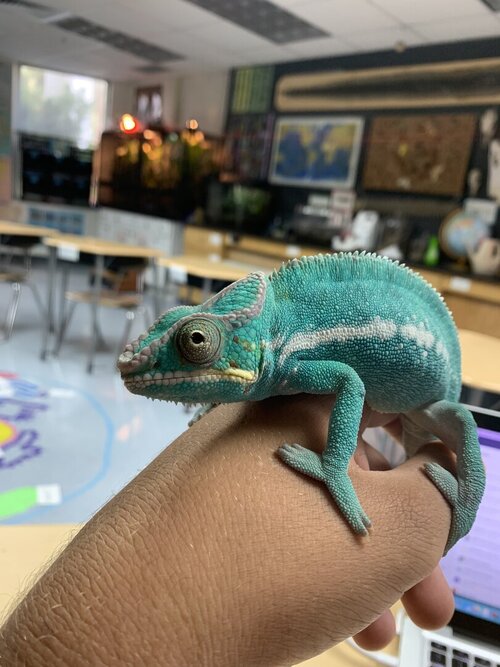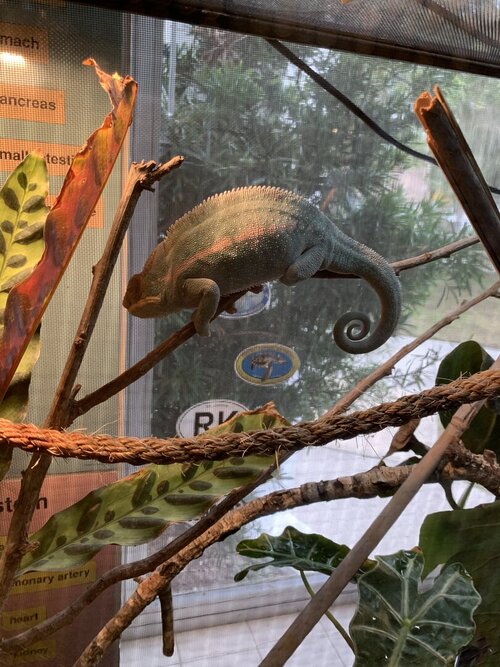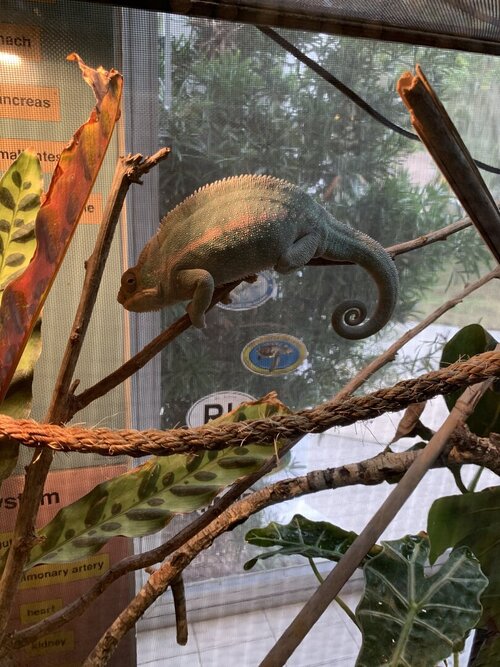ChimericalChameleons
New Member
Chameleon Info:
Cage Info:
Current Problem - Panther Chameleon acting slow and sluggish with pale colors. He started to take few short naps during the day which is what concerns me the most. The strange thing is the fact that he still feeds very well... he downed nearly around a dozen crickets today and a few more yesterday. He is just much less active and bright than he used to be. He usually shoots up my arm whenever I open the enclosure to ride around my shoulder but he does not do that anymore. I am wondering if he is due for a shed soon or needs a vet visit or is having a some kind of winter slump. I have attached 3 pictures below, the first picture where he is brightest is his usual color and the last two was from today... I woke him up from his atypical nap.
- Your Chameleon - Panther (possibly nosy-be/ambilobe cross), male, and 2 years old. He has been with me since he was 3 months old. Very bold, friendly, and usually likes to explore.
- Handling - Few times a week, he usually shoots up my arm whenever I open the enclosure to get up and ride my shoulder around the classroom. He was raised by sixth graders in a science classroom since a he was a baby and is quite fearless with people. Well behaved students may handle him during reading time (this usually happens 1-2 times a week).
- Feeding - Crickets is the staple feed with hornworm/superworm as treats once in awhile. He usually downs around 6-12 crickets per feeding. He usually is fed around 3 times a week, sometimes he'll get a bunch of crickets in his feed box and finish them over the week. I feed my crickets kale, dubia chow, and orange cubes.
- Supplements - No D3 with every feeding, multivitamins+D3 once during every other week. (repticalcium and rep-cal brands)(may switch up with what the chameleon academy recommended quite soon)
- Watering - Timed repti-zoo mister. Mists around every 4 hours during the day 30 seconds to 1 minute each soak. I see my chameleon drink whenever he is thirsty. He also has access to a slow dripper.
- Fecal Description - Feces are dark brown and solid (looks normal). Was captive born and only fed farmed insects... no signs of parasites. Parasites are highly unlikely but I will test if necessary.
- History - I accidentally switched uvb with T8 zilla desert uvb for a couple of weeks before replacing with proper T8 zilla tropical uvb this week. I do not know if this is the cause of the unusual changes in his behavior.
Cage Info:
- Cage Type - Screen enclosure made up of two combined enclosures. 6'long, 38" tall, 18" wide and he has another massive summer enclosure in the backyard porch(Florida climate).
- Lighting - T8 zilla tropical uvb, timed daily 12 hour sessions.
- Temperature - two 85F basking spots due to the width of enclosure and room temps is always around 70F. Lowest overnight temp: 70F. I have a temp gun.
- Humidity - What are your humidity levels? (uncertain) How are you creating and maintaining these levels? (Multiple potted tropical plants soak up water to boost humidity. What do you use to measure humidity?(have a small device but appears to work better in glass enclosures, i am currently in search of better tools)
- Plants - Around 10 different live tropical chameleon-safe plants.
- Placement - Where is your cage located? Near the window to allow some natural sunlight in(was suggested that recently) and he still always has plenty of shade as there is a tree front of the window so no direct burning sunlight. His enclosure is nestled in a quiet corner of my science classroom. At what height is the top of the cage relative to your room floor? Around 6'5 above the floor.
- Location - Northern Florida
Current Problem - Panther Chameleon acting slow and sluggish with pale colors. He started to take few short naps during the day which is what concerns me the most. The strange thing is the fact that he still feeds very well... he downed nearly around a dozen crickets today and a few more yesterday. He is just much less active and bright than he used to be. He usually shoots up my arm whenever I open the enclosure to ride around my shoulder but he does not do that anymore. I am wondering if he is due for a shed soon or needs a vet visit or is having a some kind of winter slump. I have attached 3 pictures below, the first picture where he is brightest is his usual color and the last two was from today... I woke him up from his atypical nap.




